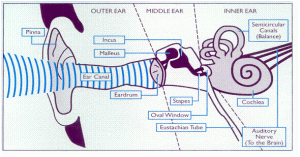Reposted from ScienceDaily (May 5, 2010) — By the time they reach school age, one in 20 children have hearing loss in one ear. That can raise significant hurdles for these children, say the results of a new study at Washington University School of Medicine in St. Louis, because loss of hearing in one ear hurts their ability to comprehend and use language.
 “For many years, pediatricians and educators thought that as long as children have one normal hearing ear, their speech and language would develop normally,” says lead author Judith E. C. Lieu, MD, a Washington University ear, nose and throat specialist at St. Louis Children’s Hospital.
“For many years, pediatricians and educators thought that as long as children have one normal hearing ear, their speech and language would develop normally,” says lead author Judith E. C. Lieu, MD, a Washington University ear, nose and throat specialist at St. Louis Children’s Hospital.“But then a few studies began suggesting these children might have problems in school. Now our study has shown that on average, children with hearing loss in one ear have poorer oral language scores than children with hearing in both ears,” Lieu says.
Hearing loss in one ear can stem from congenital abnormalities in the ear, head trauma or infections such as meningitis. Children with hearing loss in one ear may go undetected because they can appear to have normal hearing. Their difficulty hearing may be mistaken simply for lack of attention or selective hearing, says Lieu, assistant professor of otolaryngology.
Even children with recognized one-side hearing loss often aren’t fitted with hearing aids and often don’t receive accommodations for disability.
The study will be published in the June issue of the journal Pediatrics.
The researchers studied 74 six- to 12-year-old children with hearing loss in one ear. Each was matched with a sibling with normal hearing so that the researchers could minimize the possible effects of environmental and genetic factors on the children’s language skills. The children were tested with the Oral and Written Language Scales (OWLS), a widely used tool to assess language comprehension and expression.
An average OWLS score is 100, and hearing loss in one ear caused about a 10-point drop in scores. The oral composite score — which reflects both children’s ability to understand what is said to them and their ability to respond or express themselves — averaged 90 in children with hearing loss in one ear.
Lieu says that the study demonstrated the strongest effect from hearing loss in one ear in children who are living below the poverty level or with mothers who have little education. Poverty levels and maternal education levels are well-established influences on language skills, and hearing loss in one ear may increase that effect.
“This study should raise awareness that if children with hearing loss in one ear are having difficulties in speech or reading in school, their hearing may be part of the problem,” Lieu says. “Parents, educators and pediatricians shouldn’t assume that having hearing in one ear means children won’t need additional assistance.”
The study does not address which possible solutions will be most effective for overcoming the decrease in language skills seen in the children with hearing loss in one ear. But Lieu suggests that studies could be done to see if hearing aids or amplification systems in the classroom will help.
In addition, having an educational audiologist as part of an individualized educational plan might be beneficial.
“The effect of hearing loss in one ear may be subtle,” Lieu says. “These children may shun large group situations because the noise overwhelms them, and they have a hard time understanding speech. They could have difficulties playing team sports because they can’t localize sound well and can’t tell who is calling to them.
“For them, listening takes a lot more work, and they may have to put in extra effort,” Lieu says. “We don’t know yet if the hearing loss ultimately affects their overall educational achievement and eventually, even which occupations they choose.”
Story Source:
The above story is reprinted (with editorial adaptations by ScienceDaily staff) from materials provided by Washington University School of Medicine. The original article was written by Gwen Ericson.
Journal Reference:
- Lieu JEC, Tye-Murray N, Karzon RK, Piccirillo JF. Unilateral hearing loss is associated with worse speech-language scores in children. Pediatrics, 2010; 125 (6)









